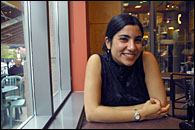Kaleidoscope
Dilshad Marolia: Wandering lawyer
 PHOTO: Owen Egan
PHOTO: Owen Egan |
|
"It's great fun to eat your way through the Zagat restaurant guide," says Dilshad Marolia of the summer she spent working at a big-ticket New York law firm. "But it's just not a lifestyle that would suit me."
Freshly graduated from McGill's Faculty of Law, the 23-year-old planned to resume working in the Big Apple come fall -- and start saving money for graduate school at some undetermined date -- but, she says, "I realized it would be very hard to break away from that kind of environment where there is so much money being thrown around."
Instead, Marolia decided to trade Manhattan for Oxford, where she starts the Master's in Law program in October. The new plan is to concentrate on human rights and refugee law, two areas of long-term interest and commitment. She has sat on the executive committee of the South Asian Women's Community Centre for five years, and regularly volunteers legal advice at the Chez Doris legal clinic -- activities which led to her being shortlisted for a YWCA Young Woman of Distinction award. But she says her choice of graduate studies was most influenced by her New York stint.
"What really concretized my interest in doing refugee work," she explains, "was realizing that I was billing far more pro bono hours than corporate hours for the firm. I was involved in two refugee projects last summer. One was a case of a Pakistani woman seeking asylum in the United States; the other was a project for the American Bar Association on the state of refugee detention centres in New York, which were basically jail conditions.
"I kept taking on more and more pro bono work," she adds with a dry laugh, "until my partner finally said, 'That's all very good, Dilshad, but maybe you should look into what the firm does.'"
Marolia was one of a handful of students accepted into McGill's law program each year without having an undergraduate degree. She says her unusual status was "quite exciting" at first, "but once I got to law school I was absolutely horrified because everyone around me had so much experience: someone had a PhD in experimental medicine, someone else had lived with Zen monks, someone else was a tax consultant -- and I'd only done calculus!"
She exaggerates. Starting at age 10, Marolia spent five years attending the Rishi Valley School. Founded in 1926 by the philosopher J. Krishnamurti, the boarding school is located on 700 acres in a remote Indian valley (the nearest city, Bangalore, is 135 km away). Enrolment is capped at 350 students (about nine per teacher), and a sliding-scale tuition ensures student backgrounds literally range from prince to pauper. The school's philosophy believes academics are only a fraction of education. Students help build, and teach in, schools in neighbouring villages, instructing children and adults alike -- and in turn learning about local history. ("We were taught that history is not just about kings and queens.") Street theatre is encouraged as a way of spreading social messages to the masses; Marolia's fifth grade teacher was Nandita Das, who has since become well known for her roles in Deepa Mehta's acclaimed Fire, Earth and Water trilogy of films. Environmentally forward-looking from its inception, Rishi Valley School also likes trees. Lots of trees. Initially barren, the valley is now home to some 5,000,000 trees, all planted over the years by school staff and students. MTV, needless to say, was not a part of the landscape.
"When people talked about pop groups," recalls Marolia, "I always said I read books and planted trees. I was a bit snobby about it, but the school really did teach me a lot. Rishi Valley is definitely a part of who I am."
After Oxford, she's committed to working for a New York firm for a year. She's open to what possibilities await after that, but working for "the United Nations High Commissioner for Refugees would be ideal, or the Red Cross. I'd like to focus on refugees in the South Asian region." Marolia is, however, firm on one point: having already lived in four countries (Iran, Singapore, Indonesia, India) before coming to Montreal, she needs to keep on the move.
"I certainly don't like being in one place for too long," she explains, "so whatever I decide to do, I'll want to do international work.
"The only permanent thing with me is change. I have itchy feet."
 |
||||
|
Men are more sensation-seeking.... They take more risks when they eat, in the movies they watch and in their love lives. |
||||
All things being equity
When you hear the word "equity" next fall, don't panic. This basic employment equity study will be a walk in the park compared to the snarled paths of the recent pay equity study.
Quebec has asked the province's universities (and other large institutions) to survey all the faculty and staff to get a snapshot of the community. Human Resources manager of records and systems, Alison Verkade, will manage the equity study, which is coordinated by Amele Djeridi. They're talking to different groups on campus to figure out how to design the survey, as well as keeping in touch with other educational institutions' human resource committees to make sure they're doing compatible studies.
The province wants to look at employment positions and gather statistics for targeted groups to ensure there are equal opportunities within employment. Verkade says the study will assess subjects like "career patterns, say, for females or aboriginals, are they different for males?
"We're hoping for a high response rate, 80-90%," Verkade says of the 4,000 - 5,000 staff members. "We'll give a bit of info about the program, and then ask people to tick off the box they think applies. It'll take 30 seconds. The longest time will be spent putting it in the envelope."
Since they anticipate doing a similar federal study sometime soon, Verkade's going to get info for two surveys with one form. The first questions fulfill both provincial and federal requirements, and will be basic. Male or female? Aboriginal? Visible minority? Mother tongue other than French or English? And in anticipation of the Federal Contractor's program's wishes, if you consider yourself disabled or not.
Easy as pie. "The complexity will be reaching people. We're not labelling, it's strictly confidential, and we'll shred all documents once everything's been verified. The database will only be accessible by myself and Amele," Verkade says. "Once we've surveyed the entire population, every quarter we'll try to catch new people as they come in."
Djeridi sees the work as "an occasion for me to work in French, my mother tongue. We have a lot of meetings, communications in French," she says. "And it's new for me. It's nice to be the first to work on it and to see how well or not we're doing on equity." Djeridi adds, "It'll be good for us and help us move forward in maybe a different way, or maybe we're doing things right."
"We think McGill stacks up really well -- that's my gut feeling," Verkade says. "We reflect the international community in our staff and students."
Surveys will go out in the fall and there will be 30 days to respond. By the beginning of 2003, Verkade and Djeridi will see if they have all they need or if they'll need to redo anything. But rest assured, they'll make it as easy as possible.
 |
||||
|
You medicalize the whole process of childbearing from start to finish. |
||||
Forensic science for cockroaches
 |
|
Every wonder what the cause of death was for that cockroach you found in the insulation of your old oven? Well, if you'd taken it to Varoujan Yaylayan's lab, he might have been able to tell you. Yaylayan is a professor of Food Science and Agricultural Chemistry and he's just published a paper in Natural Product Letters with the title "Microwave-assisted Extraction of Cockroaches."
The extraction refers to the chemicals within the infamous insect that Yaylayan and three colleagues analyzed after subjecting both dead and live cockroaches to microwave irradiation. What they found in Eurycotis floridana, one of the dead cockroaches, among a whole slew of different chemical compounds, was naphthalene and biphenyl derivatives -- known disinfectants and insecticides -- Yaylayan explains from his office at the Macdonald Campus.
"This was a dead cockroach from Florida which probably died from ingesting these chemicals."
Although the chemical analysis of the cockroaches was done largely out of curiosity, Yaylayan explains that insects and other small creatures dwelling in or on the surface of the earth may serve to detect contaminants in the environment.
But he and his team weren't only looking for the bad stories. Insects, like plants, have long been known to have medicinal qualities. They are widely used in Chinese medicine, for instance. In fact, it was C.C. Hsiung, now retired as curator of the Lyman Entomological Museum, who suggested to Yaylayan three years ago that he analyze insects, worms and the like.
Earthworms, as Yaylayan discovered in earlier research, contain a chemical compound by the name of medicarpin that has strong anti-fungal properties. "It could be used on crops, for instance," notes Yaylayan, explaining that the chemical isn't intrinsic to the worm because medicarpin is only produced by certain plants such as alfalfa. In other words, the earthworm gets it from eating the plant source.
Now if you're wondering why a live cockroach, Blaberus giganteus, was brutally killed when petroleum ether was added to the extraction vessel, this was to discover the chemicals excreted by the insect upon death. It is well known that, when threatened, cockroaches and most insects secrete a poisonous or stinky substance as a defence mechanism. What Yaylayan found was that some of the chemical compounds of the defensive secretions analyzed were the same as ant alarm pheromones (airborne hormones) belonging to the family of compounds known as aromatic alkanes.
Why would this be? Because cockroaches share their living space with ants and, evidently, some elements of their system of communication.
So, next time you're about to thump a cockroach, remember that within that black carapace dwells a veritable "hydrocarbon chemist," as Yaylayan puts it, and some of those chemicals just might be of use to us.

